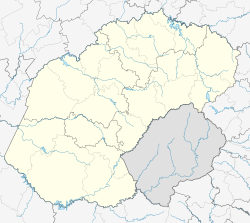Clarens, Free State
| Clarens | |
|---|---|

Clarens
|
|
|
|
|
| Coordinates: 28°31′S 28°25′E / 28.517°S 28.417°ECoordinates: 28°31′S 28°25′E / 28.517°S 28.417°E | |
| Country | South Africa |
| Province | Free State |
| District | Thabo Mofutsanyane |
| Municipality | Dihlabeng |
| Established | 1912 |
| Government | |
| • Type | Municipality |
| • Mayor | Tjhetane Mofokeng (ANC) |
| Area | |
| • Total | 13.7 km2 (5.3 sq mi) |
| Population (2011) | |
| • Total | 6,379 |
| • Density | 470/km2 (1,200/sq mi) |
| Racial makeup (2011) | |
| • Black African | 91.5% |
| • Coloured | 0.7% |
| • Indian/Asian | 0.5% |
| • White | 6.9% |
| • Other | 0.4% |
| First languages (2011) | |
| • Sotho | 84.9% |
| • English | 6.3% |
| • Afrikaans | 4.9% |
| • Sign language | 1.5% |
| • Other | 2.4% |
| Postal code (street) | 9707 |
| PO box | 9707 |
| Area code | 058 |
Clarens is a small town situated in the foothills of the Maluti Mountains in the Free State province of South Africa and nicknamed the "Jewel of the Eastern Free State". It was established in 1912 and named after the town of Clarens in Switzerland where exiled Paul Kruger spent his last days. It is situated 336 km from Johannesburg, 284 km from Bloemfontein, 389 km from Durban.
A farm called "Leliehoek" (English: Lily Corner) was bought from Hermanus Steyn in 1910, and in 1911 Piet de Villiers sold his farm "Naauwpoort" (situated near the Titanic rock) to a company wanting to establish a village there. These two farms were divided into erven and sold for fifty pounds each.
A commission was appointed in 1912 to finalize negotiations, and a decision was made to name the village "Clarens" in honour of President Paul Kruger’s influence in the area. This came about in the following way - during the Free State-Basotho War of 1865 - 1866, five "burghers" from the Transvaal were murdered in the Eastern Free State, and as a result war was declared against the Basotho leader, Moshoeshoe.
Paul Kruger, together with a commando of burghers, defeated the Basotho at the Battle of Naauwpoortnek (near Titanic rock). President Kruger spent his last days as a voluntary exile in the attractive village of Clarens in Switzerland, and thus Clarens was named for this Swiss town. A monument was erected on the farm "Ararat" just outside Clarens, in honour of the five burghers murdered by the Basotho on the 29th of September 1865, during the siege of Naauwpoort. This monument was later moved to Clarens and placed in the central town square, where it stands to this day.
Clarens is an artists' haven with many well-known artists either living in or frequenting the village, with many art galleries scattered around the village square and the town. The tranquil village ambience combined with scenic views and a mild climate has made Clarens a popular getaway for city dwellers from Johannesburg, Bloemfontein and Durban, among other places. Clarens is known for its spectacular sandstone mountains and wonderful climate; it is one of the most picturesque spots in South Africa and has recently been acclaimed as the best Trout Fishing waters in South Africa.
...
Wikipedia



